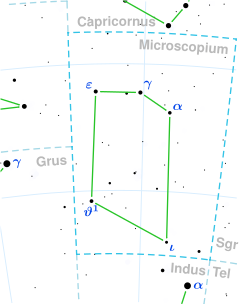| Observation data Epoch J2000.0 Equinox J2000.0 (ICRS) | |
|---|---|
| Constellation | Microscopium |
| Right ascension | 20h 46m 20.06779s[1] |
| Declination | −39° 11′ 57.3590″[1] |
| Apparent magnitude (V) | 5.47±0.01[2] |
| Characteristics | |
| Evolutionary stage | main sequence star[3] |
| Spectral type | B8/9 V[4] |
| B−V color index | −0.10[5] |
| Variable type | suspected SPB[6] |
| Astrometry | |
| Radial velocity (Rv) | −30±7.4[7] km/s |
| Proper motion (μ) | RA: +50.451 mas/yr[1] Dec.: −27.196 mas/yr[1] |
| Parallax (π) | 9.9354 ± 0.1022 mas[1] |
| Distance | 328 ± 3 ly (101 ± 1 pc) |
| Absolute magnitude (MV) | +0.49[8] |
| Details | |
| Mass | 2.83±0.04[3] M☉ |
| Radius | 2.56±0.13[9] R☉ |
| Luminosity | 73.5[10] L☉ |
| Surface gravity (log g) | 4.11±0.14[11] cgs |
| Temperature | 10,965+255 −250[12] K |
| Metallicity | 59% solar |
| Metallicity [Fe/H] | −0.23[13] dex |
| Rotational velocity (v sin i) | 290[14] km/s |
| Age | 113[11] Myr |
| Other designations | |
| Database references | |
| SIMBAD | data |
HD 197630, also known as HR 7933 or rarely 23 G. Microscopii, is a probable astrometric binary located in the southern constellation Microscopium. The visible component is a bluish-white hued star that is faintly visible to the naked eye with an apparent magnitude of 5.47.[2] Based on parallax measurements from the Gaia satellite, the system is estimated to be 328 light years away.[1] However, it is drifting closer with a heliocentric radial velocity of −30 km/s. At its current distance, HD 197630's brightness is diminished by 0.11 magnitudes due to interstellar dust.[17] A 2012 multiplicity survey failed to confirm the velocity variations.[18]
HD 197630 has a stellar classification of B8/9 V,[4] indicating that it is a B-type star with the characteristics of a B8 and B9 main sequence star. It has 2.83 times the mass of the Sun[3] and 2.56 times the Sun's radius. It radiates 73.5 times the luminosity of the Sun[10] from its photosphere at an effective temperature of 10,965 K.[12] The star is estimated to be 113 million years old,[11] having completed roughly half of its main sequence lifetime.[3] HD 19730 is spinning rapidly with a projected rotational velocity of 290 km/s.[14]

The object was in a 2002 Hipparcos variability survey and as a result,[20] the AAVSO cataloged HD 197630 as a suspected variable star that fluctuates by 0.005 magnitudes within 7.71 hours.[21] However, subsequent observations have not confirmed this. Further data from the Transiting Exoplanet Survey Satellite suggests that HD 197630 may be a slowly pulsating B-type star plus a variable star with rotation modulations.[6]
- ^ a b c d e Cite error: The named reference
GaiaDR3was invoked but never defined (see the help page). - ^ a b Cite error: The named reference
Tycho2000was invoked but never defined (see the help page). - ^ a b c d Cite error: The named reference
Zorec2012was invoked but never defined (see the help page). - ^ a b Cite error: The named reference
Houk1982was invoked but never defined (see the help page). - ^ Cite error: The named reference
Corben1971was invoked but never defined (see the help page). - ^ a b Cite error: The named reference
Pedersen2019was invoked but never defined (see the help page). - ^ Cite error: The named reference
Kharchenko2007was invoked but never defined (see the help page). - ^ Cite error: The named reference
Anderson2012was invoked but never defined (see the help page). - ^ Cite error: The named reference
Kervella2004was invoked but never defined (see the help page). - ^ a b Cite error: The named reference
McDonald2012was invoked but never defined (see the help page). - ^ a b c Cite error: The named reference
David2015was invoked but never defined (see the help page). - ^ a b Cite error: The named reference
AP1999was invoked but never defined (see the help page). - ^ Cite error: The named reference
Anders2019was invoked but never defined (see the help page). - ^ a b Cite error: The named reference
Levato2004was invoked but never defined (see the help page). - ^ Cite error: The named reference
Gould1879was invoked but never defined (see the help page). - ^ Cite error: The named reference
SIMBADwas invoked but never defined (see the help page). - ^ Cite error: The named reference
Gontcharov2017was invoked but never defined (see the help page). - ^ Cite error: The named reference
Chini2012was invoked but never defined (see the help page). - ^ Cite error: The named reference
MASTwas invoked but never defined (see the help page). - ^ Cite error: The named reference
Koen2002was invoked but never defined (see the help page). - ^ Cite error: The named reference
AASVOwas invoked but never defined (see the help page).
